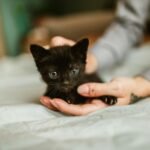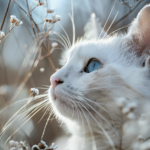Have you ever caught your cat staring at you with half-closed eyes, or curling up in the same sunny spot every afternoon? If so, you’ve witnessed some of the everyday habits that whisper secrets about your feline friend’s feelings. Cat lovers everywhere know how mysterious their pets can be—sometimes affectionate, sometimes aloof, and always a little unpredictable. Yet, beneath that cool exterior, cats are constantly giving us clues about how safe, happy, and content they feel in their homes. These daily patterns do more than just amuse us—they reveal the true emotional comfort of our whiskered companions. Let’s dive into the fascinating world of feline behavior and uncover the top 10 routines that show your cat is truly at ease.
Slow Blinking and Soft Eye Contact

If you’ve ever noticed your cat blinking slowly at you, consider it a loving gesture. Cats use slow blinking as their way of saying, “I trust you.” Unlike a hard stare, which can signal aggression or fear, a slow blink is the ultimate sign of relaxation. When your cat holds your gaze, then gently closes and opens their eyes, it’s almost like a feline kiss. This pattern often happens when they’re perched comfortably or lounging near you. It’s their way of inviting connection without feeling threatened. Try returning the gesture by blinking slowly back—many cats will answer in kind, cementing a bond of mutual comfort.
Consistent Grooming Routines

A cat that spends time grooming itself is often a content cat. Licking their fur is more than just staying clean—it’s a soothing ritual that helps regulate emotions. Regular, thorough grooming indicates your cat feels safe enough to focus on self-care. You might see your cat pause to wash after eating, napping, or even after a stressful moment to reset their mood. Over-grooming, however, can be a sign of anxiety, so it’s the calm, steady routines that best show comfort. When your cat grooms in your presence, it’s a sign they trust you and consider their environment secure.
Seeking Out Sunbeams and Favorite Spots

Cats instinctively seek warmth and comfort, often returning to the same sunny window or cozy bed each day. These chosen spots are their personal sanctuaries. When a cat repeatedly snuggles into familiar places, it’s a clear sign they feel emotionally safe. You’ll notice them stretching, rolling, or even dozing deeply in these areas, completely at ease. Sometimes, your cat may knead the blanket or bed with their paws, a leftover kitten habit that brings comfort. Watching your cat return to the same spot day after day is proof they feel secure in their territory.
Playful Bursts and “Zoomies”

Sudden bursts of playful energy—often called “zoomies”—are a joyful display of feline comfort. Whether dashing down the hallway or leaping onto furniture, these wild sprints show that your cat feels uninhibited and happy. Play is an essential outlet for cats, letting them express their natural hunting instincts in a safe way. When your cat engages in regular play, either alone or with you, it’s a sign of emotional health. Cats who feel anxious or threatened are less likely to play openly. So, those surprise sprints and acrobatic jumps are more than just entertainment—they’re a window into your cat’s well-being.
Gentle Kneading and Purring

When your cat purrs and kneads you or their favorite blanket, it’s a sure sign of deep comfort. Kneading goes back to kittenhood, when nursing kittens press their paws against their mother. Adult cats keep this behavior as a way to self-soothe and express happiness. Pair it with a rumbling purr, and you have a double dose of contentment. This pattern often appears when your cat is winding down for a nap or cuddling beside you. It’s their way of saying they feel safe, loved, and at peace in your presence.
Following You from Room to Room

If your cat shadows you throughout the house, it’s not just curiosity—it’s a sign of trust and attachment. Cats are naturally independent, but when they choose to be near you, it speaks volumes about their comfort. You might find your feline companion quietly observing you from a doorway or settling nearby while you work. This habit shows they feel emotionally secure and enjoy your company. Even if they don’t always want to be held or petted, their presence is a gentle reminder that you’re their favorite person.
Chirping, Trilling, and Soft Vocalizations

Cats communicate a lot through their voices. When your cat greets you with soft chirps, trills, or gentle meows, it’s usually a sign of emotional comfort. These sounds are distinct from the loud yowls of distress or the hissing of fear. Instead, they’re reserved for happy moments—like seeing you come home or spotting a bird outside the window. Some cats even “talk” to their owners during play or cuddle sessions, sharing their feelings in their own unique language. Responding with affection only strengthens the bond and reassures your cat they’re safe.
Stretching Out and Sleeping Belly-Up

A cat that sleeps on its back, exposing its belly, is showing the ultimate sign of trust. In the wild, this position is vulnerable, so a cat will only do this when they feel completely protected. You might see your cat stretch out luxuriously, paws in the air, or flop onto their side in a sunbeam. Deep, relaxed sleep in open spaces is a clear indicator your cat feels at ease in their surroundings. If your cat dozes belly-up in your presence, it’s their way of saying, “I feel secure here.”
Calm Eating and Drinking Habits

A cat that eats and drinks calmly, without darting glances or hesitation, is likely experiencing emotional comfort. Cats are naturally cautious when it comes to mealtimes, since eating can make them feel vulnerable. When a cat leisurely enjoys their food, lingers at their water bowl, or even “grazes” throughout the day, it signals a sense of safety. Watch for contented chewing, relaxed posture, and the occasional pause to look around with soft eyes. These behaviors suggest your cat trusts their environment and feels no need to rush or guard their food.
Gentle Head Butts and Rubbing Against You

When your cat greets you with a gentle head butt, or rubs their face and body against your legs, they’re marking you as part of their safe space. Cats have scent glands on their heads and cheeks, and by rubbing you, they’re mingling their scent with yours—a loving gesture that signals belonging. This pattern often appears during greetings or relaxed moments. A cat that regularly seeks to touch you, nuzzle your hands, or snuggle close is saying, in their own way, “I’m comfortable, and you’re my family.”

Linnea is a born and bred Swede but spends as much time as possible in Cape Town, South Africa. This is mainly due to Cape Town’s extraordinary scenery, wildlife, and atmosphere (in other words, because Cape Town is heaven on earth.) That being said, Sweden’s majestic forests forever hold a special place in her heart. Linnea spends as much time as she can close to the ocean collecting sea shells or in the park admiring puppies.






